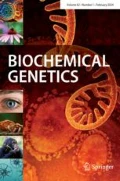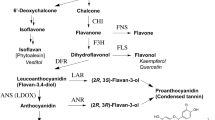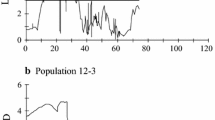Abstract
The influence of the gene Pr on flavonoid 3′-hydroxylase activity in maize is described. Specific activities are presented for the hydroxylase in seedlings and aleurone tissue homozygous dominant and recessive and heterozygous for Pr. Specific activity levels in both tissues increased in a nearly direct proportion with the increase in Pr dosage, which is consistent with Pr being the structural gene for the hydroxylase. Regression analysis of the gene dosage:enzyme activity comparison yielded correlation coefficients of 0.979 and 0.959 for the seedlings and aleurone, respectively. Quantitative identification of the cyanidin and pelargonidin in the aleurone indicated that cyanidin increased with an increase in dominant Pr, while pelargonidin decreased, although the increases and decreases observed were not directly proportional to the gene dosage. Comparison of the cyanidin/pelargonidin ratio to the gene dosage ratio in the different tissues showed a strong correlation (0.998), which demonstrates that the dosage of Pr controls the ratio of cyanidin to pelargonidin. Cyanidin was found at a low concentration in aleurone homozygous for pr. Hydroxylase activity in maturing field plants reaches its peak concentration near anthesis and is present at an appreciable concentration in mature plant tissue homozygous for pr, as well as in seedlings homozygous for pr. Suggestion is made that pr could be a hypomorphic allele or that a duplicate gene for Pr could exist to account for the hydroxylase activity in homozygous pr tissue. Evidence for the hydroxylase in the aleurone and the seedlings and the pigment ratio data from the aleurone suggest that Pr is indeed a structural gene for NADPH:flavonoid 3′-hydroxylase.
Similar content being viewed by others
References
Bradford, M. (1976). A rapid and sensitive method for the quantitation of microgram quantities of protein utilizing the principle of protein-dye binding. Anal. Biochem. 72248.
Chen, S.-M. (1973). Anthocyanins and Their Control by the C Locus in Maize Ph.D. thesis, University of Missouri, Columbia.
Coe, E. H., Jr. (1955). Anthocyanin synthesis in maize, the interaction of A2 and Pr in leucoanthocyanin accumulation. Genetics 40568.
Coe, E. H., Jr., and Neuffer, M. G. (1977). The genetics of corn. In Sprague, G. F., (ed.), Corn and Corn Improvement, Amer. Soc. Agron., pp. 111–223.
Dooner, H. K. (1983). Coordinate genetic regulation of flavonoid biosynthetic enzymes in maize. Mol. Gen. Genet. 189136.
Dooner, H., and Nelson, O. E. (1977). Genetic control of UDPglucose:flavonol 3-0-glucosyltransferase in the endosperm of maize. Biochem. Genet. 15509.
East, E. M., and Hayes, H. K. (1911). Inheritance in maize. Conn. Agr. Exp. Sta. Bull. 167.
Folch, J., Less, M., and Sloane-Stanley, G. H. (1957). A simple method for the isolation and purification of total lipids from animal tissue. J. Biol. Chem. 226497.
Harborne, J. B., and Gavazzi, G. (1969). Effect of Pr and pr alleles on anthocyanin biosynthesis in Zea mays. Phytochemistry 8999.
Kirby, L. T., and Styles, T. D. (1970). Flavonoids associated with specific gene action in maize aleurone, and the role of light in substituting for the action of a gene. Can. J. Genet. Cytol. 12934.
Larson, R. L., and Bussard, J. B. (1986). Microsomal flavonoid 3′-monooxygenase from maize seedlings. Plant Physiol. 80 (in press).
Larson, R. L., and Coe, E. H., Jr. (1968). Enzymatic action of the Bz anthocyanin factor in maize. Proc. XIII Int. Cong. Genet. 1131.
Larson, R. L., and Coe, E. H., Jr. (1977). Gene-dependent flavonoid glucosyltransferase in maize. Biochem. Genet. 15153.
McClary, J. E. (1942). The anthocyanin pigments of corn. Maize Genet. Coop. News Lett. 1630.
Sando, C. E., Milner, R. T., and Sherman, M. S. (1935). Pigments of the Mendelian color types in maize. Chrysanthemin from purple-husked maize. J. Biol. Chem. 109203.
Styles, E. D., and Ceska, O. (1977). The genetic control of flavonoid synthesis in maize. Can. J. Genet. Cytol. 19289.
Zarudnaya, K. I. (1950). A Chromatographic Study of Anthocyanins and Related Substances in Various Genotypes of Maize Ph.D. thesis, University of Missouri, Columbia.
Author information
Authors and Affiliations
Additional information
Cooperative Investigations, Agricultural Research Service, United States Department of Agriculture, and Missouri Agricultural Experiment Station, Columbia, Missouri 65211. Journal Series No. 9958.
Rights and permissions
About this article
Cite this article
Larson, R., Bussard, J.B. & Coe, E.H. Gene-dependent flavonoid 3′-hydroxylation in maize. Biochem Genet 24, 615–624 (1986). https://doi.org/10.1007/BF00504338
Received:
Revised:
Issue Date:
DOI: https://doi.org/10.1007/BF00504338




